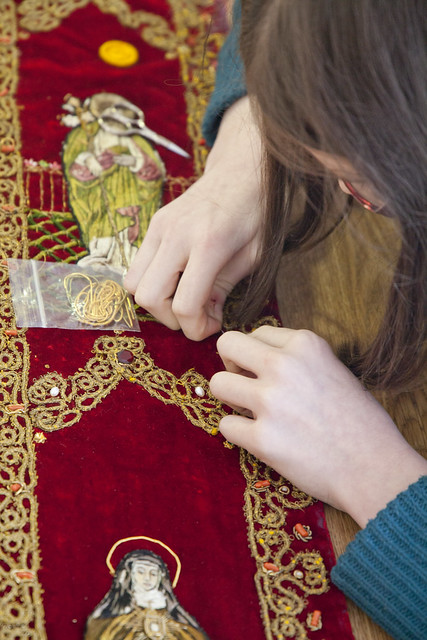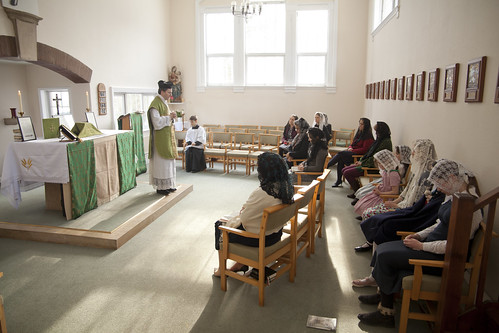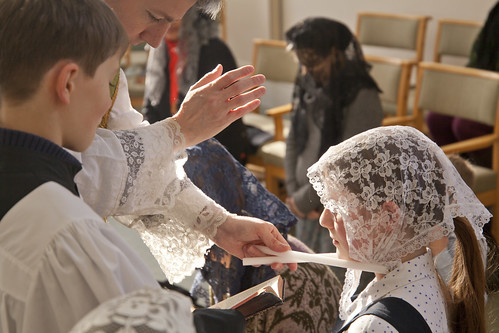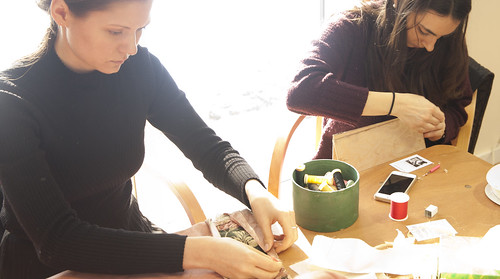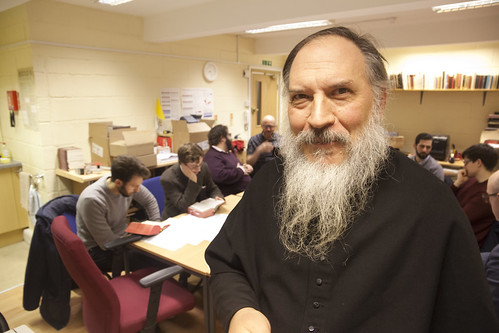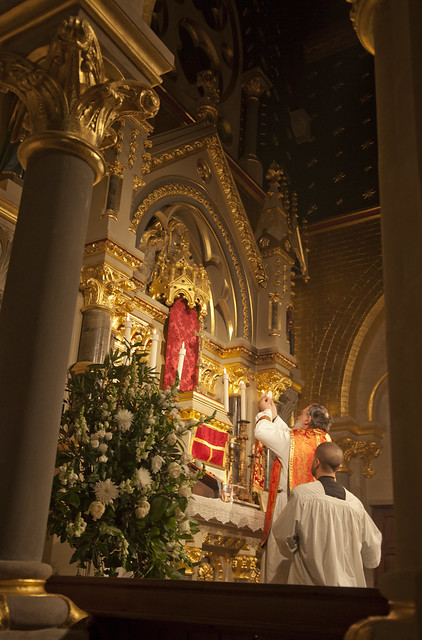Chairman's Blog
Sinners in the Queue for Communion
 |
| Queuing for Holy Communion in Westminster Cathedral at the LMS Annual Requiem |
A lot of the acrimonious debate about Amoris Laetitia boils down to the question of Catholics in a state of grave sin wishing to receive Holy Communion. Such difficulties are not new to the Church, which has long included unjust rulers, men who have mistresses, people enjoying the fruits of crime, and such like. Indeed, in one respect the situation was more difficult in past centuries, because more people voluntarily excluded themselves from receiving, to such an extent that in the High Middle Ages most lay Catholics only received Communion once a year, on Easter Sunday.
Bad photographs showcased by the Catholic Herald
Another week, another rather second-rate photograph given the full-page treatment in the Catholic Herald. This time, as well as the poor lighting, the camera appears to have been focused on the altar (hardly visible in the gloom), whereas the brightly-lit reredos some distance behind it is out of focus.
I'm sure a common response to my curmudgeonly comments will be that I should be more charitable to what is, presumably, an amateur photographer sending in a snap to the Catholic Herald for which he will not even be paid. This response, however, is part of the cult of mediocrity which has done huge damage to the Church, and should be ruthlessly uprooted wherever it is found.
Naturally, small, charitable Catholic associations and impoverished parishes struggle to produce professional-looking publicity, or music; they struggle with the legal obligations imposed by data-processing, safeguarding, and employment law; they can't always answer the phone or process requests for documents as quickly as one would wish. The Latin Mass Society is in the same category. But let us not embrace a culture of incompetence, half-hardheartedness, and kindergarten artistic standards as if it were a good thing in itself. Let us at least continue the struggle against the difficulties inevitable to under-resourced organisations.
And when there is a supposedly professional, commercial institution in our midst, like the shiny new magazine-format Catholic Herald, let us hold it to decent standards. Enough of this rubbish.
As I wrote on this blog some years ago:
I think most people can tell when a parish fails to rise to great heights of artistry through sheer lack of resources. The state of the building and nature of the parishioners will tell you enough. Such a situation, where poverty is matched with zeal, has made many Catholic artists want to contribute to community life at their own cost, as an act of charity. When artistic mediocrity is matched with pile carpets, expensive sound-systems and a well-heeled congregation, then you know that it is ideological.
Here is the letter which the Catholic Herald declined to publish. In trying to be charitable, I cast the blame on the lighting in this particular case, but the fact is they should never have published the photograph I refer to.
Is repentance possible?
Support the Latin Mass Society
Guild of St Clare Sewing Retreat, Spring 2019: photos and report
Cross-posted from the Guild of St Clare blog.
This year's spring Guild of St Clare Sewing Retreat, like last year's, took place in the snow: last time it was the 'Beast from the East' in early March. By now we knew the route up Boars Hill which doesn't turn into a toboggan run for cars, so the disruption was manageable. I had even bought the car some 'snow socks' and other widgets for bad weather, which came in handy.
The last day of the Retreat, Sunday, also happened to be St Blaise's feastday, and we had the Blessing of Throats.
Lots of sewing was done, and various large projects for the Latin Mass Society and others were brought closer to completion. The Retreat was sold out--numbers are limited--and much edified by Fr Edward van den Burgh's spiritual conferences, Masses, and other devotions, and also by his joining in the sewing himself! He went home with advice on the repairs of one liturgical item he had brought with him and completed repairs on others.
Support the Latin Mass Society
Children at Mass: against Fr Michael White
 |
| An infant receiving the Blessing of Throats on the Feast of St Blase, during the Guild of St Clare Sewing Retreat, at Boars Hill, Oxford. |
I've written a fair amount on this topic on this blog; here is a piece I've done for LifeSiteNews.
It begins:
Blow the trumpet in Sion, sanctify a fast, call a solemn assembly. Gather together the people, sanctify the church, assemble the ancients, gather together the little ones, and them that suck at the breasts: let the bridegroom go forth from his bed, and the bride out of her bridal chamber.
And the people being all assembled together, both men and women, children and strangers, that are within thy gates.
Support the Latin Mass Society
Dialogos Institute colloquium 2019: Integralism
14TH - 15TH JUNE 2019, NURSIA, ITALY
The Second Vatican Council spoke of the “traditional Catholic doctrine on the moral duty of men and societies toward the true religion and toward the one Church of Christ”. Over the course of the last seventeen hundred years this his duty has been realised in many different ways. In recent years the concept of Integralism has inspired renewed interest and controversy. This summer eight scholars from around the world will gather in Norcia to consider the vision and the reality of a broad cross section of integrally Christian societies.
SPEAKERS include Prof Tom Pink, Fr Thomas Crean, Dr Alan Fimister and Fr Edmund Waldstein.
Covington: don't blame social media
My latest on LifeSiteNews.
People looking at social media over the first 48 hours of the story were presented with a wall of vituperation directed at the Covington boys, and this very naturally influenced their response. However, social media also speeded up the dissemination of a fuller set of evidence. In the old days of newspapers, steam-trains, and telegraphs, there was still a gap between initial, slanted reports of events, and later, fuller information, and still the urge among commentators to make statements before the fuller information became available: if it ever did.
Read the whole thing there.
St Albert the Great Summer School at Norcia 2019 on the Gospel of John
June 16th – 28th In Norcia, Italy
Full details here.
John Houghton Schola launched at Maiden Lane
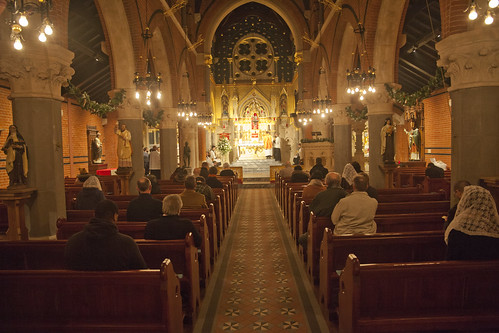 |
| Corpus Christi, Maiden Lane, in London, following recent restoration. |
The Latin Mass Society's new London Chant Schola, the Schola Cantorum Ioannis Hougton, has now had its first rehearsal and accompanied its first Mass.
The Masses at 6:30pm on Mondays at Corpus Christi Maiden Lane present a problem from the musical point of view because London-based singers find it difficult to get there in time for an extended rehearsal before Mass starts, after their work day. So the Houghton Schola rehearses on the previous Friday evening, in the Latin Mass Society's Office. I attended the first of these myself, as did the Schola's Chaplain, the usual celebrant at the Maiden Lane Masses, Fr Gabriel Diaz Patri.
The Schola's eight members turned out to have every level of experience--from 'lots' to 'none'--and it will be very interesting to see them develop as a group. The first Mass went extremely well, thanks to the seriousness of the singers and the preparation and leadership of Matthew Schellhorn, its director and the Latin Mass Society's Director of Music for London.
18th Feb; 11th March; 15th April; 13th May; 10th June.
Support the Latin Mass Society
Cafeteria Catholics won't save the Church
My latest on LifeSiteNews


